
Kitchen Sink Buying Guide
Other than the kitchen table where families gather each day, the kitchen sink is typically the centerpiece of the kitchen, where meals start and end. Used for both the preparation and cleaning up of meals throughout the day, the modern kitchen sink must be rugged enough to stand up to repeated daily use. With modern technology, kitchen sinks can be both sturdy and aesthetically pleasing. Different sink styles, such as rustic farmhouse and vintage fireclay, lend character to what is often the most used kitchen appliance. Let Vintage Tub & Bath help you choose the perfect sink for your kitchen with our extensive buying guide.
KITCHEN SINK STYLES
FARMHOUSE SINKS
Often referred to as farm, country, or apron sinks, these popular kitchen sinks are known for their deep, wide basins that make scrubbing large pots and pans easy, while preventing water from splashing back up onto the person washing the dishes or the countertop. The front part of the sink, or the apron, protrudes approximately one to two inches from the countertop.
In addition to the typical sink options — such as material, finish, the number of basins — one must also choose an apron design when purchasing a farm sink. There are a variety of apron designs available including decorative lip, fluted, hammered, recessed, and smooth. Choose the apron design that best fits your kitchen’s aesthetics.
DROP-IN SINKS
Also called a top mount sink or a self-rimming sink, a drop-in sink is dropped into the countertop with the lip overlapping the counter for support and stability. These kitchen sinks are popular because they are easy to install and, if necessary, remove.
UNDERMOUNT SINKS
These kitchen sinks are raised into place from below and secured using mounting hardware. Undermount sinks are very functional since no part of the sink is sitting on the countertop, they offer a clean and simple look. This also makes cleanup easier, as crumbs can be swept straight into the sink. These sinks are typically used with solid surface countertops, such as granite.
WALL MOUNT SINKS
Often spotted in mudrooms and laundry rooms, wall-mounted sinks are also a great option for the kitchen. They save space and allow for greater flexibility, as they can be installed however high or low you desire.
PREP SINKS
Also referred to as a bar sink, a prep sink is a second sink that sits apart from the main kitchen sink. Prep sinks are extremely useful, especially if there are normally multiple people working in the kitchen at one time. These sinks allow multiple cooks to prepare, cook and clean up at the same time. They’re generally used for small tasks, but in a small kitchen they can serve as the main sink to conserve space.
KITCHEN SINK MATERIALS
FIRECLAY
This highly durable material is fired at high heat to ensure the sink resists chips and scratches. Fireclay sinks won’t fade, rust, or discolor and are available in a wide variety of finishes and styles, including farmhouse, drop-in, undermount, and prep sinks. Fireclay has a similar appearance to porcelain but is much more durable. These sinks have a nonporous surface, making them resistant to bacteria.
CAST IRON
Durable and easy to maintain, cast iron is a popular material for kitchen sinks. The porcelain enamel surface is smooth, making cast iron sinks easy to clean. These sturdy sinks are resistant to chipping and cracking, however, if the porcelain is chipped, exposing the cast iron, the sink can rust. Therefore, make sure to use a sink grid in your cast iron sink.
STAINLESS STEEL
Stainless steel sinks are available in a variety of gauges. The gauge relates to the thickness of the sink; the higher the gauge, the thinner the steel. These kitchen sinks are lightweight, durable, and easy to clean. You don’t have to worry about chips or cracks, and stainless steel is stain resistant. Choose from several styles, including farmhouse, drop-in, undermount, and prep sinks. Most stainless steel sinks are sound deafening, to reduce the noise produced by the sink.
COPPER
Copper sinks are attractive and easy to maintain. Since copper is naturally antimicrobial, cleaning is a breeze. Simply wipe the sink down with a soft cloth and mild soap, as well as an occasional wax to maintain the sinks finish. These sinks are durable, eco-friendly, resistant to rust and corrosion, and have a long lifespan. Copper is also a self-healing material. Acidic substances will brighten the copper’s surface, but the copper will soon begin to re-patina itself. The more often a copper sink is used, the faster the re-patina will occur.
STONE & GRANITE
Usually composed of natural stones like granite, marble, dolomite, and NativeStone (a combination of Jute fiber and concrete), this sink type isn’t something you’d normally think of as a material. Stone kitchen sinks need regular maintenance, as well as a stone sealer, applied every few months. No two sinks are alike, so natural stone can add an elegant and unique look to your kitchen.
KITCHEN SINK SIZES & OPTIONS
KITCHEN SINK SIZES
Kitchen sinks do not have a standard size, but there is a huge variety in the different sizing options they do come in. From as small as 9-inches to as large as 40-inches in length, finding the right sink to fit your kitchen is imperative. Although there is no standard size, 30-inch and 33-inch are the most common sizes available, but the most common range for sink size is a length of 24-inch – 36-inch. Sinks over 36-inches are considered oversized and work well in a larger kitchen where a smaller sink might not fit the aesthetic and design. Sinks that are up to 30-inches are generally single bowl while anything over that can be a double or even triple bowl, but single bowl sinks can still be this large as well. Don’t just think about sink size in terms of length, think about basin depth as well and how the sink will be used. Will you be hand washing dishes? Will you be using this sink for food prep? These are important considerations to keep in mind.
NUMBER OF BOWLS
The size of the kitchen and how the sink will be used will determine the number of bowls needed.
Single Bowl
The most common bowl option, the single bowl is a popular classic found in many homes across the country. A big advantage to single bowl sinks is with its large depth it can easily handle larger pots, pans, and baking sheets for handwashing or soaking whereas double and triple bowls may not have enough space to accommodate, as the bowl divider may get in the way. These sinks are perfect for smaller kitchens.
Double Bowl
Double bowl sinks create separate workstations for soaking, cleaning, and rinsing. One sink can be your soaking station while the other is for washing. These sink types work well in larger kitchen spaces and are available in a combination of basin splits, including 50/50, 60/40, or 70/30.
Triple Bowl
These sinks are usually set up with a 40/20/40 split where one of the larger bowls is used for the garbage disposal and the other is used for food prep. The smaller bowl usually holds the food to be prepared or smaller items.
DRAINBOARD
Some sinks come with drainboards, which are great for keeping the countertop clean and dry. They can also be used for collecting food scraps during meal prep. With a drainboard kitchen sink, you may even find yourself washing dishes by hand more often and using the dishwasher less.
REVERSIBLE SINKS
These are typically farmhouse sinks that are finished on all four sides. Each long side features a different design, allowing you to choose the side you like best. Apron fronts feature this design so if you want to show off the apron or not is totally up to you.
OTHER CONSIDERATIONS
FAUCET COMPATIBILITY
Some sinks will come with predrilled faucet holes allowing for easy installation into the sink itself instead of the countertop. Be mindful of how many holes are drilled in order to accommodate the right type of faucet.
DRAIN POSITION
The most common drain location is in the center of the sink, but some can be offset to the back or rear corner allowing for more surface area.
GARBAGE DISPOSAL COMPATIBILITY
There needs to be enough clearance to install a garbage disposal underneath the sink. If installing a new deeper sink, you’ll need to measure the sink bowl depth and base height of the cabinetry to know if one can be installed or replaced.
SINK GRIDS
Avoid chips, nicks, and scuff damage from heavy kitchen items like pots, pans, and dishes by using a sink grid. The sink grid sits on top of the base of the sink and holds all these items above the actual surface like a platform. They are usually a wire grid to let the water drain off items properly.
SINK DRAINS & DISPOSER FLANGES
For sinks with no garbage disposals attached underneath. The strainer basket collects all food particles that were drained off from washing and allows for simple cleanup by disposing of them in the garbage. Sinks with garbage disposals need a flange installed which doesn’t have a strainer so particles can flow into the disposal. A disposer flange also comes with a drain plug for easily filling the sink.
AIR GAP KITS
In some states, a code requirement states that an air gap kit is necessary to prevent backflow from sink to dishwasher.
SOAP DISPENSERS
Keep your counter space uncluttered with an undermount soap. These come in multiple finishes to match your sink faucet perfectly.
FREQUENTLY ASKED QUESTIONS (FAQ)
DO I NEED AN UNDERMOUNT KIT?
Undermount sinks are not sold with undermount kits but can be added on at an additional cost. We recommend that farmhouse sinks and undermount sinks be installed with an undermount kit for added support.
DO I NEED A SINK GRID?
Fireclay & porcelain sinks are delicate in nature, so it would be 100% beneficial to purchase a sink grid with one of these sinks to protect it from chips and scratches.
DOES MY KITCHEN SINK NEED AN EXTENED BASKET STRAINER?
Most fireclay, stone and granite sinks require an extended basket strainer or garbage disposal flange due to the thickness of the sink.
HOW CAN I CLEAN MY SINK?
Keeping a kitchen sink clean isn’t as hard as you would think. Here are some tips on how to clean them by material:
Fireclay/Porcelain/Cast Iron
Simply clean with dish soap and warm water and wipe down with a cloth or sponge. For tough stains, use a little elbow grease and a non-abrasive cleaner.
Stainless Steel
Rinse thoroughly after each use and wipe dry with a soft cloth. For a deeper clean, use hot water and gentle dish soap with a soft cloth. Never use abrasive cleaners or sponges, such as steel wool or wire brushes on your cast iron sink. Leaving dirty dishes, coffee grounds, tea bags, or other materials in your sink for a long period of time can stain the surface.
Copper
As easy as it can be, use mild dish soap, water, and a soft sponge. For tougher stains, use baking soda.
Stone/Granite
Clean with mild dish soap and water and for touch stains use a 50/50 solution of water and vinegar, rinse, and wipe dry.
CAN I REPLACE A CENTER DRAIN KITCHEN SINK WITH AN OFFSET DRAIN SINK?
Yes, but additional installation and plumbing may be required. Be sure to consult with your contractor or plumber before moving forward with installation.
HOW DO I KNOW WHAT SINK SIZE I NEED?
A proper fit is necessary when installing a new sink to determine the proper size for your space. First, remove your current sink and measure the length and width of the opening. Next, measure the depth of the current sink bowl to ensure a snug fit. If you want to replace a shallow sink with a deeper one, measure the existing plumbing to ensure proper drainage and no plumbing modification is necessary behind the wall, such as lowering the pipe. To be sure you won’t need any modifications, measure the sink drainpipe that connects to the tee under the sink by length. This is called the tailpipe. If this pipe is 2-inches long, then you have 2-inches of depth for a deeper sink without any issues or modification.
WHAT IS A STANDARD KITCHEN SINK SIZE?
Although there is no standard kitchen sink size, 30-inch and 33-inch are the most common sizes available. Most common sinks range from 24-inch – 36-inch in length. A “standard” size kitchen sink will depend on your kitchen design and your specific needs. A 36-inch sink works well in a larger kitchen where a 24-inch sink might work well for a smaller kitchen.
WHAT TYPE OF KITCHEN SINK IS BEST?
Every kitchen sink has its pros and cons, so choosing the best one will depend on your needs. If you are still unsure what sink to purchase after reading this Kitchen Sink Buying Guide, feel free to contact our knowledgeable Product Experts at 877.868.1369 ext 1 or via chat. They will be able to assist you in deciding what type of kitchen sink is best for your specific space.

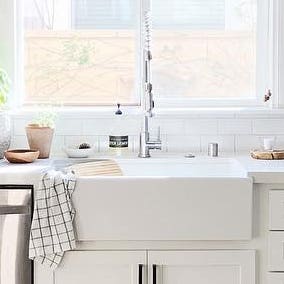


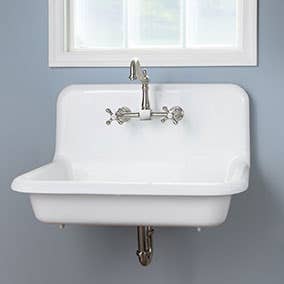


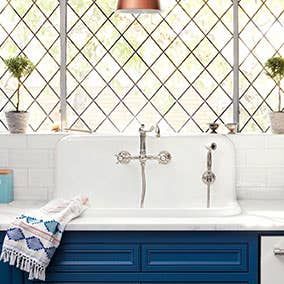
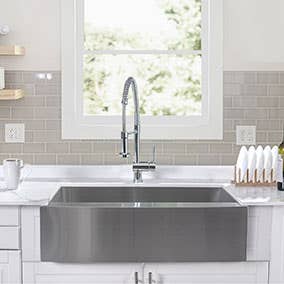


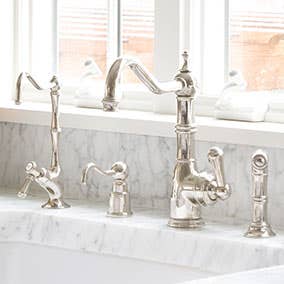
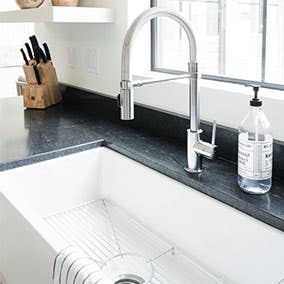
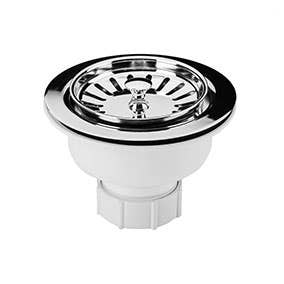

Login and Registration Form